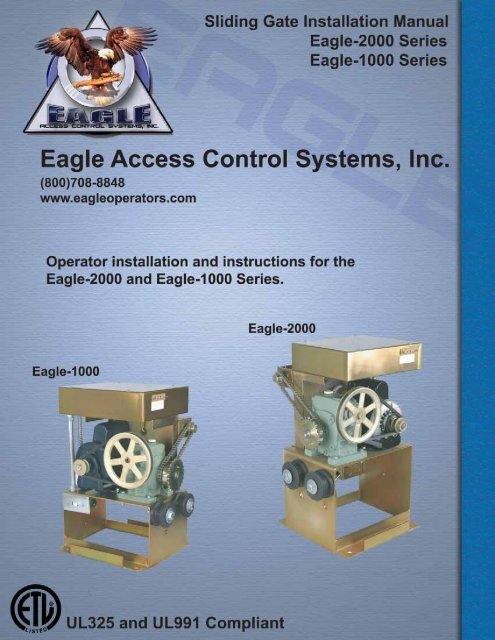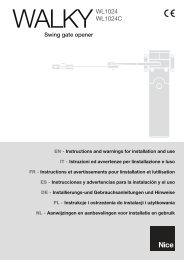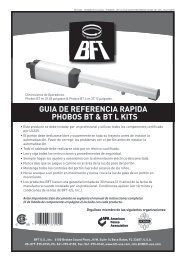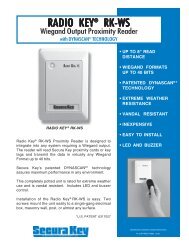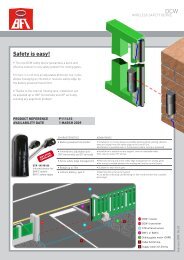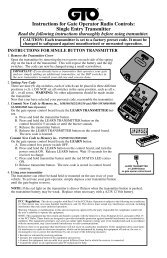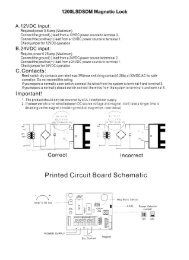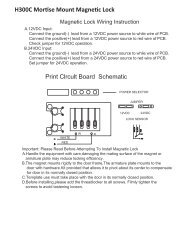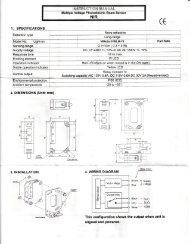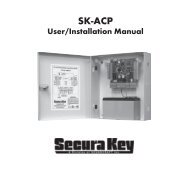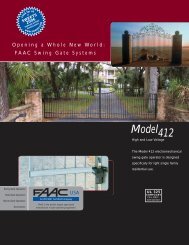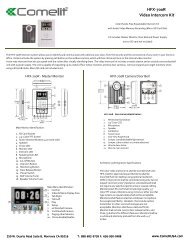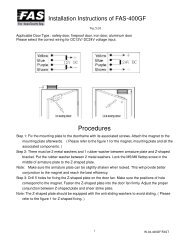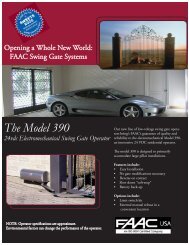Eagle-1000 Installation Manual - Eagle Access Control Systems, Inc.
Eagle-1000 Installation Manual - Eagle Access Control Systems, Inc.
Eagle-1000 Installation Manual - Eagle Access Control Systems, Inc.
You also want an ePaper? Increase the reach of your titles
YUMPU automatically turns print PDFs into web optimized ePapers that Google loves.
UL Listings<br />
IMPORTANT SAFETY INSTRUCTIONS<br />
A. WARNING – To reduce the risk of injury or death:<br />
1) READ AND FOLLOW ALL INSTRUCTIONS.<br />
2) Never let children operate or play with gate controls. Keep the remote control away from<br />
children.<br />
3) Always keep people and objects away from the gate. NO ONE SHOULD CROSS THE<br />
PATH OF THE MOVING GATE.<br />
4) Test the gate operator monthly. The gate MUST reverse on contact with a rigid object or<br />
stop when an object activates the non-contact sensors. After adjusting the force or the<br />
limit of travel, retest the gate operator. Failure to adjust and retest the gate operator<br />
properly can increase the risk of injury or death.<br />
5) Use the emergency release only when the gate is not moving.<br />
6) KEEP GATES PROPERLY MAINTAINED. Read the owner’s manual. Have a qualified<br />
service person make repairs to gate hardware.<br />
7) The entrance is for vehicles only. Pedestrians must use separate entrance.<br />
8) SAVE THESE INSTRUCTIONS.<br />
A. Install the gate operator only when:<br />
1) The operator is appropriate for the construction of the gate and the usage Class of the<br />
gate,<br />
2) All openings of a horizontal slide gate are guarded or screened from the bottom of the<br />
gate to a minimum of 4 feet (1.22 m) above the ground to prevent a 2-1/4 inch (57.2 mm)<br />
diameter sphere from passing through the openings anywhere in the gate, and in that<br />
portion of the adjacent fence that the gate covers in the open position,<br />
3) All exposed pinch points are eliminated or guarded, and<br />
4) Guarding is supplied for exposed rollers.<br />
B. The operator is intended for installation only on gates used for vehicles. Pedestrians must be<br />
supplied with a separate access opening. The pedestrian access opening shall be designed to<br />
promote pedestrian usage. Locate the gate such that persons will not come in contact with the<br />
vehicular gate during the entire path of travel of the vehicular gate.<br />
C. The gate must be installed in a location so that enough clearance is supplied between the gate<br />
and adjacent structures when opening and closing to reduce the risk of entrapment. Swinging<br />
gates shall not open into public access areas.<br />
D. The gate must be properly installed and work freely in both directions prior to the installation of<br />
the gate operator. Do not over-tighten the operator clutch or pressure relief valve to compensate<br />
for a damaged gate.<br />
E. For gate operators utilizing Type D protection:<br />
1) The gate operator controls must be placed so that the user has full view of the gate area<br />
when the gate is not moving.<br />
2) The placard provided marked in letters at least 1/4-in (6.4-mm) high with the word<br />
″WARNING″ and the following statement or the equivalent: ″Moving Gate Has the<br />
Potential of Inflicting Injury or Death – Do Not Start Gate Unless Path is Clear″ shall be<br />
placed adjacent to the controls,<br />
3) An automatic closing device (such as a timer, loop sensor, or similar device) shall not be<br />
employed, and<br />
4) No other activation device shall be connected.<br />
<strong>Eagle</strong> <strong>Access</strong> <strong>Control</strong> <strong>Systems</strong>, <strong>Inc</strong>. / (800) 708-8848 / www.eagleoperators.om<br />
(3)
F. <strong>Control</strong>s intended for user activation must be located at least six feet (6’) away from any<br />
moving part of the gate and where the user is prevented from reaching over, under, around or<br />
through the gate to operate the controls. Outdoor or easily accessible controls shall have a<br />
security feature to prevent unauthorized use.<br />
G. The Stop and/or Reset button must be located in the line-of-sight of the gate. Activation of the<br />
reset control shall not cause the operator to start.<br />
H. A minimum of two (2) WARNING SIGNS shall be installed, one on each side of the gate where<br />
easily visible.<br />
I. For gate operators utilizing a non-contact sensor in accordance Usage Class:<br />
1) See instructions on the placement of non-contact sensors for each Type of application,<br />
2) Care shall be exercised to reduce the risk of nuisance tripping, such as when a vehicle,<br />
trips the sensor while the gate is still moving, and<br />
3) One or more non-contact sensors shall be located where the risk of entrapment or<br />
obstruction exists, such as the perimeter reachable by a moving gate or barrier.<br />
J. For a gate operator utilizing a contact sensor in accordance with Usage Class:<br />
1) One or more contact sensors shall be located where the risk of entrapment or obstruction<br />
exists, such as at the leading edge, trailing edge, and post-mounted both inside and<br />
outside of a vehicular horizontal slide gate.<br />
2) One or more contact sensors shall be located at the bottom edge of a vehicular vertical lift<br />
gate.<br />
UL Listings (continued)<br />
3) One or more contact sensors shall be located at the pinch point of a vehicular vertical<br />
pivot gate.<br />
4) A hardwired contact sensor shall be located and its wiring arranged so that the<br />
communication between the sensor and the gate operator is not subjected to mechanical<br />
damage.<br />
5) A wireless contact sensor such as one that transmits radio frequency (RF) signals to the<br />
gate operator for entrapment protection functions shall be located where the transmission<br />
of the signals are not obstructed or impeded by building structures, natural landscaping or<br />
similar obstruction. A wireless contact sensor shall function under the intended end-use<br />
conditions.<br />
6) One or more contact sensors shall be located on the inside and outside leading edge of a<br />
swing gate. Additionally, if the bottom edge of a swing gate is greater than 6 inches (152<br />
mm) above the ground at any point in its arc of travel, one or more contact sensors shall<br />
be located on the bottom edge.<br />
7) One or more contact sensors shall be located at the bottom edge of a vertical barrier<br />
(arm).<br />
UL 325 MODEL CLASSIFICATIONS<br />
Class I (Residential vehicular gate operator) - A<br />
vehicular gate operator (opener or system)<br />
intended for use in a home of one to four single<br />
family dwellings, or a garage or parking area<br />
associated therewith.<br />
Class II (Commercial / General access vehicular<br />
gate operator) - A vehicular gate operator (opener<br />
or system) intended for use in a commercial<br />
location or building such as a multi-family housing<br />
unit (five or more single family units), hotel,<br />
garages, retail store, or other buildings servicing<br />
the general public.<br />
Class III (Commercial / General access vehicular<br />
gate operator) - A vehicular gate operator (opener<br />
or system) intended for use in an industrial<br />
location, loading dock area, or other location not<br />
intended to service the general public.<br />
Class IV (Commercial / General access vehicular<br />
gate operator) - A vehicular gate operator (opener<br />
or system) intended for use in a guarded<br />
industrial location or buildings such as airport<br />
security area or other restricted access locations<br />
not servicing the general public, in which<br />
unauthorized access is prevented via supervision<br />
by security personnel<br />
<strong>Eagle</strong> <strong>Access</strong> <strong>Control</strong> <strong>Systems</strong>, <strong>Inc</strong>. / (800) 708-8848 / www.eagleoperators.om<br />
(4)


